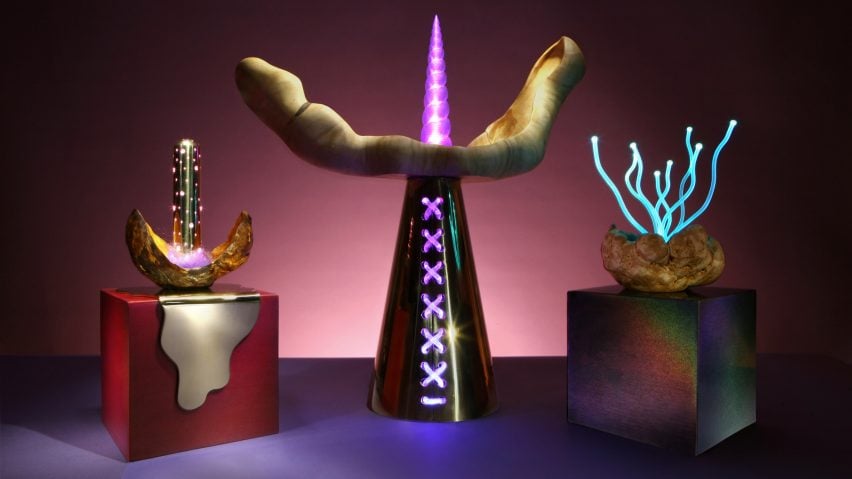Swedish artist Aia Jüdes has given gnarled tree offshoots a new lease on life by turning them into a series of lights decorated with rainbow LEDs, velvet scrunchies and shining puddles of brass.
The project, which was unveiled as part of Stockholm Design Week, features more than 20 lamps with abstract shapes that variously resemble "little creatures" with fibre optic tentacles or bioluminescent flowers.
Each is made from an outgrowth, called a burl, which forms on the trunks and branches of some trees as a sort of knobbly lump.
These are either hollowed out to form bulbous bowls or stripped of their bark to reveal the spiky interior. They are then propped up on a menagerie of holographic cubes and metallic cones for an aesthetic Jüdes describes as "burls on acid".
"I lived in Japan for a while and became really fascinated with the Shintoist idea that different elements of nature actually have a spirit," she told Dezeen.
"From that perspective, a burl is actually not a defect. Each one is unique, like a diamond of the forest. I wanted to reveal the inner magic that I see in these burls and show them in a new light – pun intended."
Jüdes sourced half of the burls for the collection from flea markets. The other half came from Erling Tällberg, an octogenarian artisan from a fringe subculture of burl carvers who live in the forests of western Sweden.
He is among the few devotees that have carried on this craft, which originated in the time of the Vikings but has since largely fallen out of fashion save for a brief revival in the 1960s and 70s.
Jüdes believes this might be because carving a single burl can involve more than 100 man-hours.
"Because burls are seen as imperfections, they're not really allowed to grow in commercial forests, so first you have to go out into old-growth forest to find one," she explained.
"Then you have to pick it without hurting the tree too much and dry it for weeks and even months before you can start to figure out who this burl is, because every burl is different."
The outgrowths are also extraordinarily dense and strong because their fibres have grown in all directions rather than just in one. As a result, the most time-intensive part of the process is the actual carving and polishing of the wood.
"I wanted to take this old craft technique and material and give it a new context to make it more interesting for today's generation," said Jüdes.
"So I combined them with LED light and fibre optics, and then added different materials like hand-crocheted mohair, fresh water pearls and 3D-printed shells. I also worked with one of the last brass smiths in Sweden to form the base plates."
Although they may look like plastic or metal, the cubes which the lights are perched on actually consist of birch wood that has been painted with textile colour and chromatic lacquer to reflect light like an oil slick.
"I've always been intrigued by contrasts," the designer said. "I want to talk about slightly darker issues like deforestation and the environmental crisis we are facing but in a new, playful way."
In keeping with this spirit, the collection will be turned into a touring exhibition for children after its stint at Galleri Sebastian Schildt, where it will be on show until 22 February.
"I hope the project will be a starting point for conversations with young kids, so they can learn about wood, the forest, animals and ecosystems," she explained.
"Nature has a lot to teach us and hopefully, since the lights are sort of little creatures, they can become like their friends."
Environmental concerns manifested themselves in a variety of different projects presented at Stockholm Design Week – from a mix-it-yourself soap that cuts out plastic waste, to an award-winning, reusable stand and a collection of furniture that was shaped using natural forces rather than machines.
Other projects, meanwhile, have similarly experimented with using was wood. For example, Atelier NL has created benches from storm-felled trees, while Tel Aviv-based Hilla Shamia cast trunks with molten aluminium to create a collection of seats.

